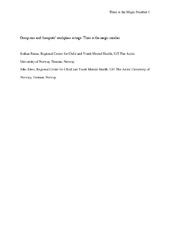Group size and therapists’ workplace ratings: Three is the magic number
Permanent lenke
https://hdl.handle.net/10037/8743Dato
2015-04-21Type
Journal articleTidsskriftartikkel
Sammendrag
Summary. The present implementation study compares therapists’ workplace ratings of collective efficacy, collaboration, and teamwork in Norwegian child welfare and child psychiatric agencies. Participating therapists were trained in Parent Management Training Oregon model (PMTO) as part of a nationwide implementation of the program. Participating therapists (N = 83) worked in 67 Norwegian social service agencies. Respondents were part of three conditions: (1) PMTO therapists working in agencies with no other PMTO therapists (n = 45), (2) two PMTO therapists working together in the same agency (n = 23), and (3) three therapists working together in the same agency (n = 15).
Findings. Therapists working in clusters of 3 rated their workplaces more positively than therapists who worked in agencies with 1 or 2 PMTO interventionists, β = .29, p = .03; Cohen’s d = .80. The result was independent of agency size, leadership quality, service population, and therapist education. There was no difference in workplace ratings between PMTO therapists working in agencies in pairs (2 PMTO therapists) and those working in agencies alone (1 PMTO therapist), p = .45.
Applications. PMTO therapists working in clusters of three appeared to have better experiences with their workplace than therapists with no other PMTO colleagues, and those with only one other PMTO colleague. This result suggests that clustering therapists together in groups of at least three may create a better work environment for therapists using newly-implemented interventions.
Beskrivelse
This is a submitted version of the article (pre-print). Published version at http://doi.org/10.1177/1468017315581564.


 English
English norsk
norsk